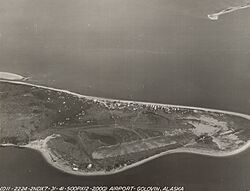Golovin, Alaska facts for kids
Quick facts for kids
Golovin
Головин (Russian)
|
|
|---|---|

Golovin, 1941
|
|
| Country | United States |
| State | Alaska |
| Census Area | Nome |
| Incorporated | March 26, 1971 |
| Area | |
| • Total | 4.13 sq mi (10.71 km2) |
| • Land | 4.13 sq mi (10.71 km2) |
| • Water | 0.00 sq mi (0.00 km2) |
| Elevation | 43 ft (13 m) |
| Population
(2020)
|
|
| • Total | 175 |
| • Density | 42.32/sq mi (16.34/km2) |
| Time zone | UTC-9 (Alaska (AKST)) |
| • Summer (DST) | UTC-8 (AKDT) |
| ZIP code |
99762
|
| Area code | 907 |
| FIPS code | 02-29180 |
| GNIS feature ID | 1402760 |
Golovin is a small city in Nome Census Area, Alaska, United States. Its original names were Chinik (from Inupiaq: Siŋik or Central Yupik: Cingik) and Russian: Головин. In 2020, about 175 people lived there.
Contents
Where is Golovin located?
Golovin is found in western Alaska. It sits on a piece of land between Golovnin Bay and Golovnin Lagoon. This area is part of the Seward Peninsula.
- It is about 105 kilometers (65 miles) east of Nome.
- The bay and lagoon are named after Russian Vice-Admiral Vasily Golovnin.
- The city's name is a slight misspelling of his last name.
- The city covers about 10.71 square kilometers (4.13 square miles) of land.
How many people live in Golovin?
| Historical population | |||
|---|---|---|---|
| Census | Pop. | %± | |
| 1890 | 38 | — | |
| 1900 | 140 | 268.4% | |
| 1930 | 135 | — | |
| 1940 | 116 | −14.1% | |
| 1950 | 94 | −19.0% | |
| 1960 | 59 | −37.2% | |
| 1970 | 117 | 98.3% | |
| 1980 | 87 | −25.6% | |
| 1990 | 127 | 46.0% | |
| 2000 | 144 | 13.4% | |
| 2010 | 156 | 8.3% | |
| 2020 | 175 | 12.2% | |
| U.S. Decennial Census | |||
The city of Golovin first appeared on the U.S. Census in 1890. It was then known as the native village of Ikaleaveagmiut. In 1900, it was called Cheennik Village.
- Golovin officially became a city in 1971.
- In 2000, there were 144 people living in Golovin.
- Most residents are Native American.
- Many households in Golovin have children under 18.
- The average household has about three people.
What is the history of Golovin?
Golovin was first an Inupiat village called Chiŋik.
Naming of Golovin
The city is named after Captain Vasily Golovnin. He was a Russian Navy captain. He visited Alaska between 1807 and 1819. He was checking on the Russian-American Company.
Gold Rush Era
In 1842, Lt. Lavrenty Zagoskin reported the village as "Ikalikguigmyut." Later, in 1867, a church and school were built south of the current city.
- Around 1890, John Dexter opened a trading post. This post became a key place for gold prospectors.
- Gold was found in 1898 near Council.
- Golovin became an important supply point for the gold fields.
- Ships would unload supplies in Golovin. These supplies were then sent by boat to the gold fields.
After the Gold Rush
When gold was discovered in Nome, many people moved there. This caused Golovin's population to shrink.
- Around 1900, Reindeer herding began in the area.
- Today, Golovin is a checkpoint for the famous Iditarod dog sled race.
Who are some notable people from Golovin?
- Donny Olson is an important person from Golovin. He is an Alaska State Senator. He is also a lawyer, pilot, doctor, and reindeer herder.
See also
 In Spanish: Golovin (Alaska) para niños
In Spanish: Golovin (Alaska) para niños


